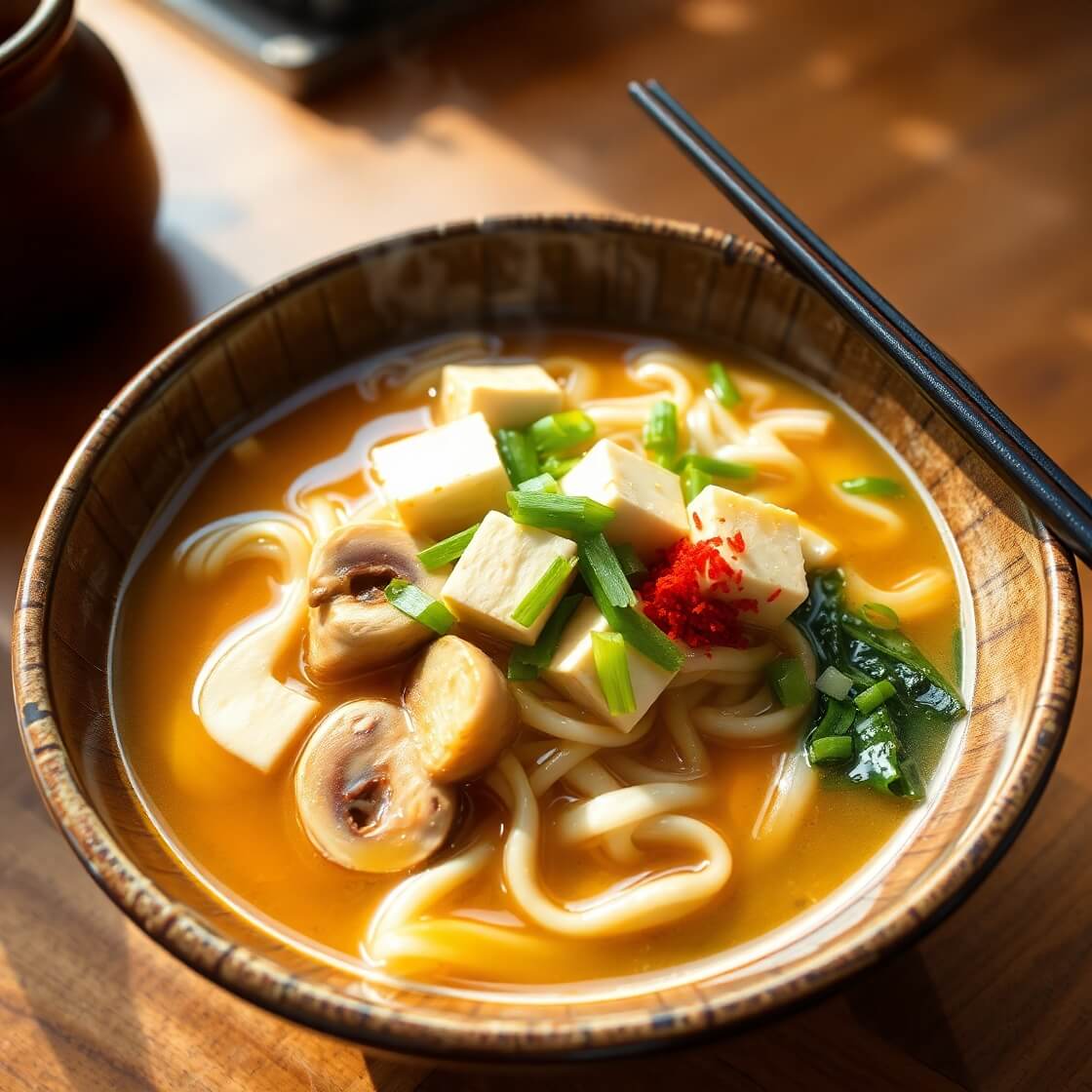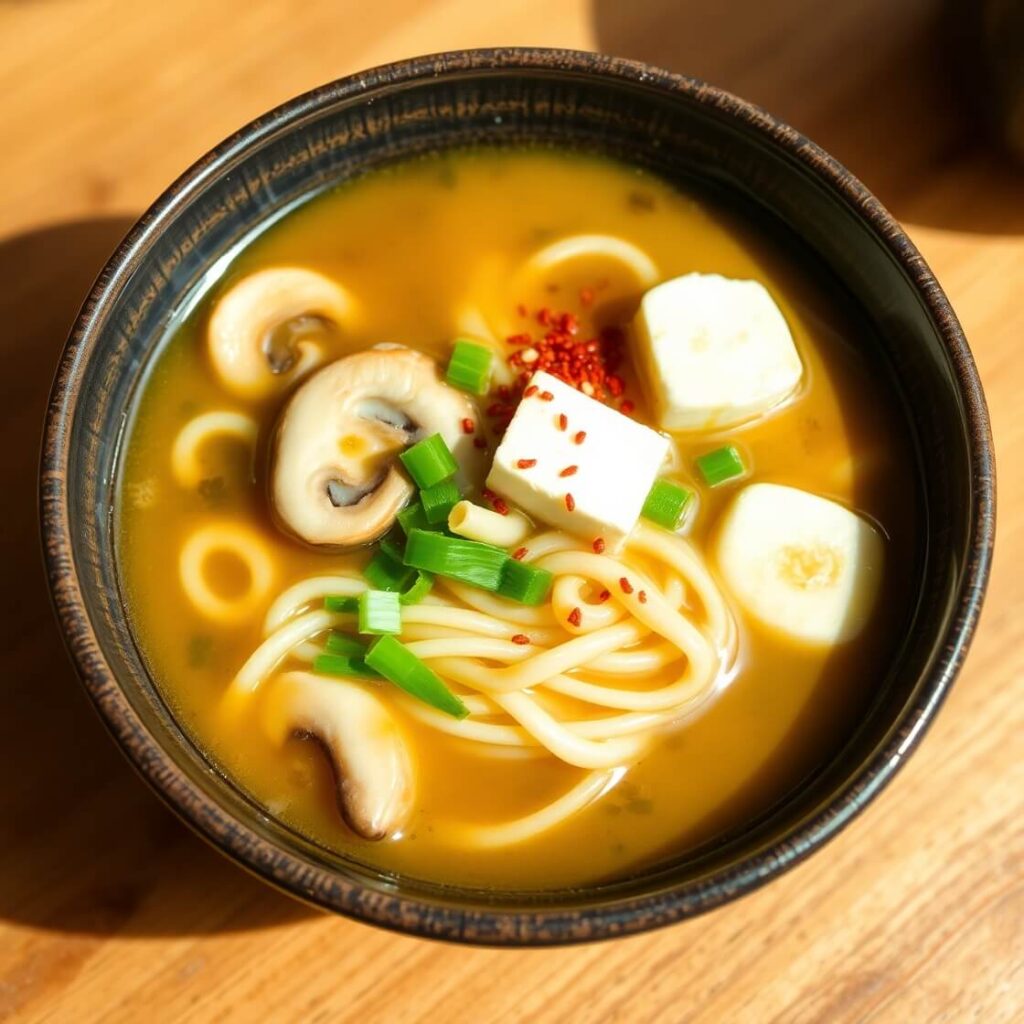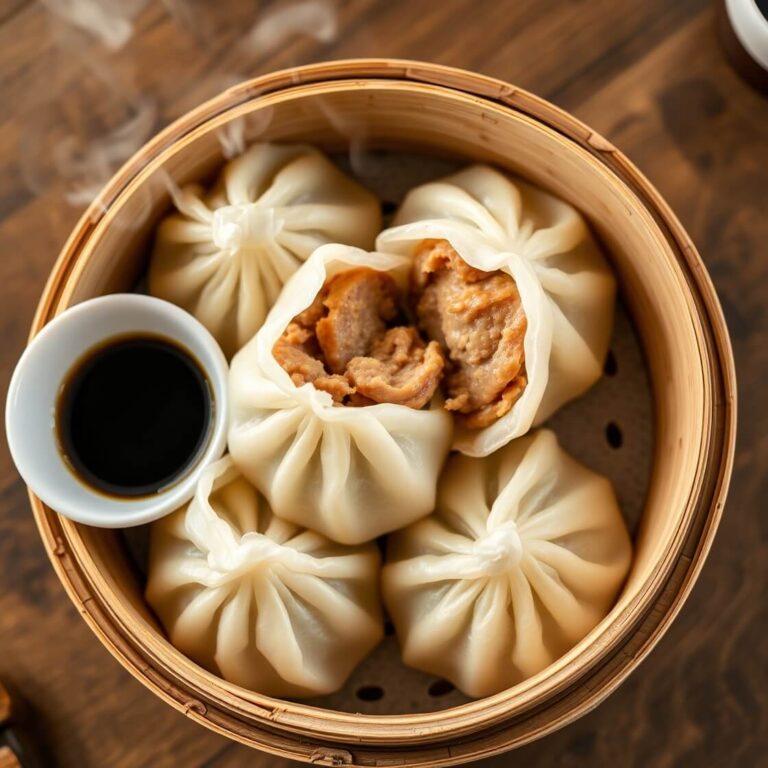Udon noodle soup is one of those comforting dishes that always feels like a warm hug on a chilly day. It’s a classic Japanese soup featuring thick, chewy udon noodles in a flavorful broth. I first made this recipe because I wanted something simple yet deeply satisfying, a meal that’s easy to prepare but packs a rich taste. Whether you’re craving a light lunch or a cozy dinner, udon noodle soup offers that perfect balance of savory warmth and comforting texture. If you’ve never tried it before, or even if you’re a longtime fan, I promise this recipe will make you want to keep a pot simmering on your stove all winter long.
Keep reading to discover how easy it is to make authentic udon noodle soup at home, with tips and tricks to bring out its full flavor.
Why I Love This Recipe
What I truly love about udon noodle soup is how versatile and wholesome it is. The broth is the star here—traditionally made from dashi, a Japanese stock that’s light yet deeply umami. Combined with the soft, chewy udon noodles, it creates a comforting dish that fills you up without feeling heavy.
This soup can be dressed up or down with simple toppings like scallions, tempura, or mushrooms, or even proteins like chicken or tofu. That makes it a perfect weeknight meal when you want something quick but nourishing. Plus, udon noodles have this wonderful texture that feels substantial but not overwhelming.
People make this soup because it’s both soothing and flexible—great for cold weather but also refreshing when served lighter. The balance of salty, savory broth and chewy noodles hits all the right notes for many palates. This recipe captures all that goodness with an easy approach anyone can follow.
Ingredients for Udon Noodle Soup
For a truly delicious udon noodle soup, the ingredients are straightforward but carefully chosen.
First, you need udon noodles—fresh or frozen udon works best for that perfect chewy bite. Dried udon can be used, but it takes longer to cook and sometimes lacks that authentic texture.
The broth base is essential. Traditional dashi powder or homemade dashi stock gives the soup its umami depth. You’ll also need soy sauce and mirin for seasoning to create that delicate balance of salty and slightly sweet flavors.
Some ginger and garlic add subtle warmth, while green onions or scallions provide freshness as a garnish.
Depending on your preference, you might want to add mushrooms like shiitake or enoki for earthiness, or proteins such as soft tofu or thinly sliced beef or chicken.
Lastly, a touch of toasted sesame oil or a sprinkle of shichimi togarashi (Japanese chili powder) can add an extra layer of flavor if desired.
Each ingredient plays a role in building a harmonious soup that is both satisfying and light.
How Much Time Will You Need
One of the best things about udon noodle soup is that it doesn’t demand hours in the kitchen.
Preparing the broth and assembling the ingredients takes about 10 to 15 minutes, especially if you use pre-made dashi or dashi powder.
Cooking the noodles and simmering everything together typically takes another 10 minutes.
So in total, you’re looking at roughly 25 to 30 minutes from start to finish, making it ideal for busy weeknights or last-minute meals.
The quick cooking time doesn’t sacrifice any of the comforting flavors—you’ll have a hearty, warming soup on the table faster than many other homemade dishes.
How to Make This Udon Noodle Soup
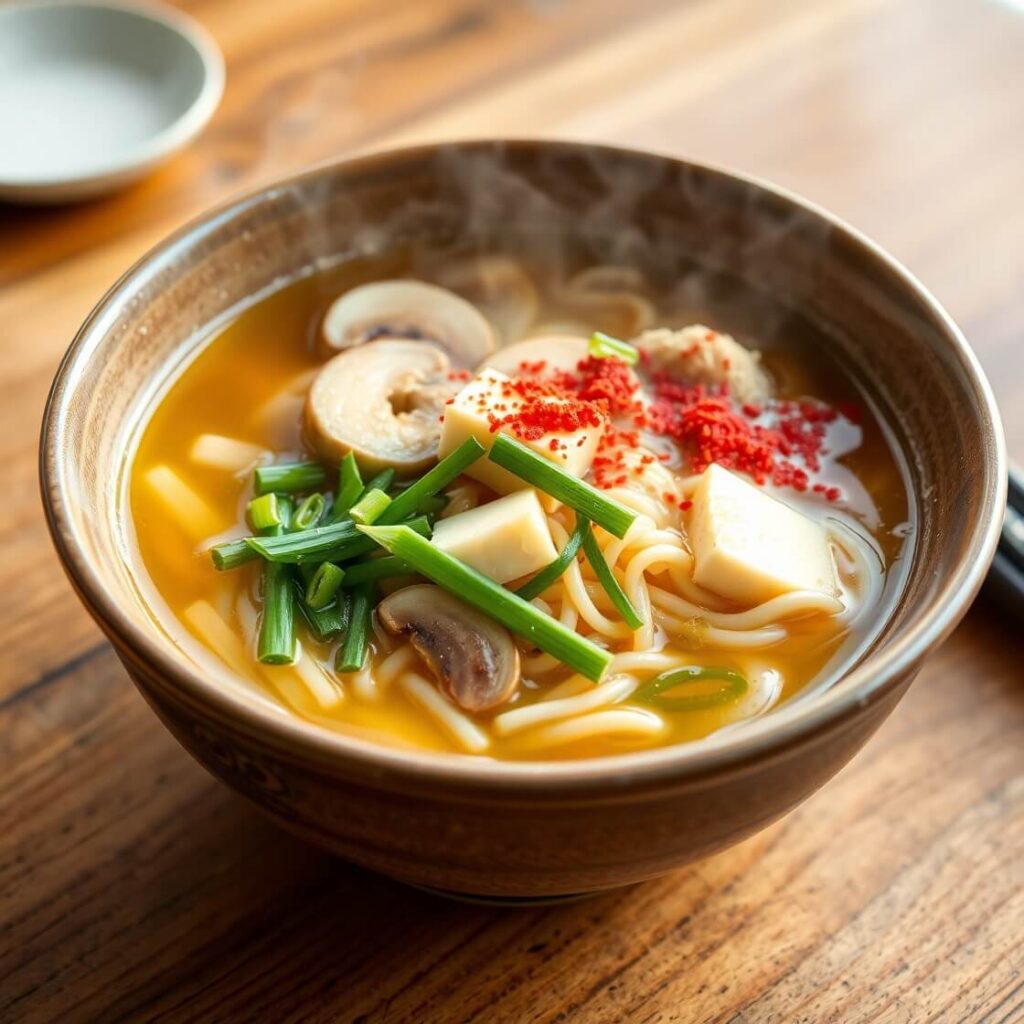
Step 1: Prepare your broth by combining dashi stock (homemade or from powder) with soy sauce and mirin in a pot. Bring it to a gentle simmer over medium heat.
Step 2: While the broth warms, prepare your udon noodles according to the package instructions. Fresh or frozen noodles usually just need to be boiled for a few minutes until tender.
Step 3: If you’re adding mushrooms or proteins, slice them thinly so they cook quickly. Add mushrooms first to the simmering broth and let them soften for 3 to 4 minutes.
Step 4: Add your protein next. If you’re using tofu, add it gently to avoid breaking it up. If using thinly sliced beef or chicken, simmer just until cooked through, usually about 2 to 3 minutes.
Step 5: Drain the cooked noodles and divide them into serving bowls.
Step 6: Ladle the hot broth with mushrooms and protein over the noodles.
Step 7: Garnish generously with chopped scallions, a drizzle of toasted sesame oil, and if you like, a sprinkle of shichimi togarashi for a mild kick.
Step 8: Serve immediately while hot, and enjoy the cozy, satisfying flavors.
Substitutions
Udon noodle soup is forgiving and adaptable, so feel free to tailor it to your pantry or dietary preferences.
If you don’t have dashi, you can substitute with a light vegetable broth combined with a splash of soy sauce and a bit of kombu (dried kelp) or shiitake mushroom soaking liquid for umami.
For noodles, if udon isn’t available, thick wheat noodles or even thick rice noodles can work, though the texture will be different.
Instead of mirin, a mixture of sugar and white wine or rice vinegar can add the sweet balance.
If you want to skip soy sauce for gluten-free or low-sodium options, tamari or coconut aminos work well.
To add variety, swap mushrooms for other vegetables like bok choy, spinach, or thinly sliced carrots.
Protein substitutions include tempeh, seitan, or even seafood like shrimp or fish cakes.
These swaps allow you to keep the spirit of udon noodle soup while making it your own.
Best Side Dish of Udon Noodle Soup
To complement your udon noodle soup, try pairing it with these side dishes:
- Gyoza (Japanese Pan-Fried Dumplings): Their crispy bottoms and savory fillings add a delightful contrast to the smooth soup.
- Edamame with Sea Salt: Light and healthy, edamame pods are a simple snack to nibble alongside.
- Japanese Pickled Vegetables (Tsukemono): The tangy crunch balances the rich broth perfectly.
These sides elevate the meal, making it feel more complete and restaurant-worthy without complicated prep.
Serving and Presentation Tips
When it comes to serving udon noodle soup, presentation can really elevate the experience. One simple way to impress is to serve the soup in deep, rustic bowls that hold heat well, keeping your soup warm longer.
Garnish is key—freshly chopped scallions, a few thin slices of bright green bok choy or spinach, and a sprinkle of toasted sesame seeds add color and texture that make the dish visually appealing. A small sheet of nori (seaweed) tucked gently on the side adds an elegant touch.
Consider placing a small dipping dish with soy sauce or a drizzle of chili oil nearby for guests who want to customize their soup’s flavor.
Serving with wooden chopsticks and a ceramic soup spoon completes the authentic Japanese dining feel, making every spoonful inviting and satisfying.
Tips and Tricks to Make This Recipe Better
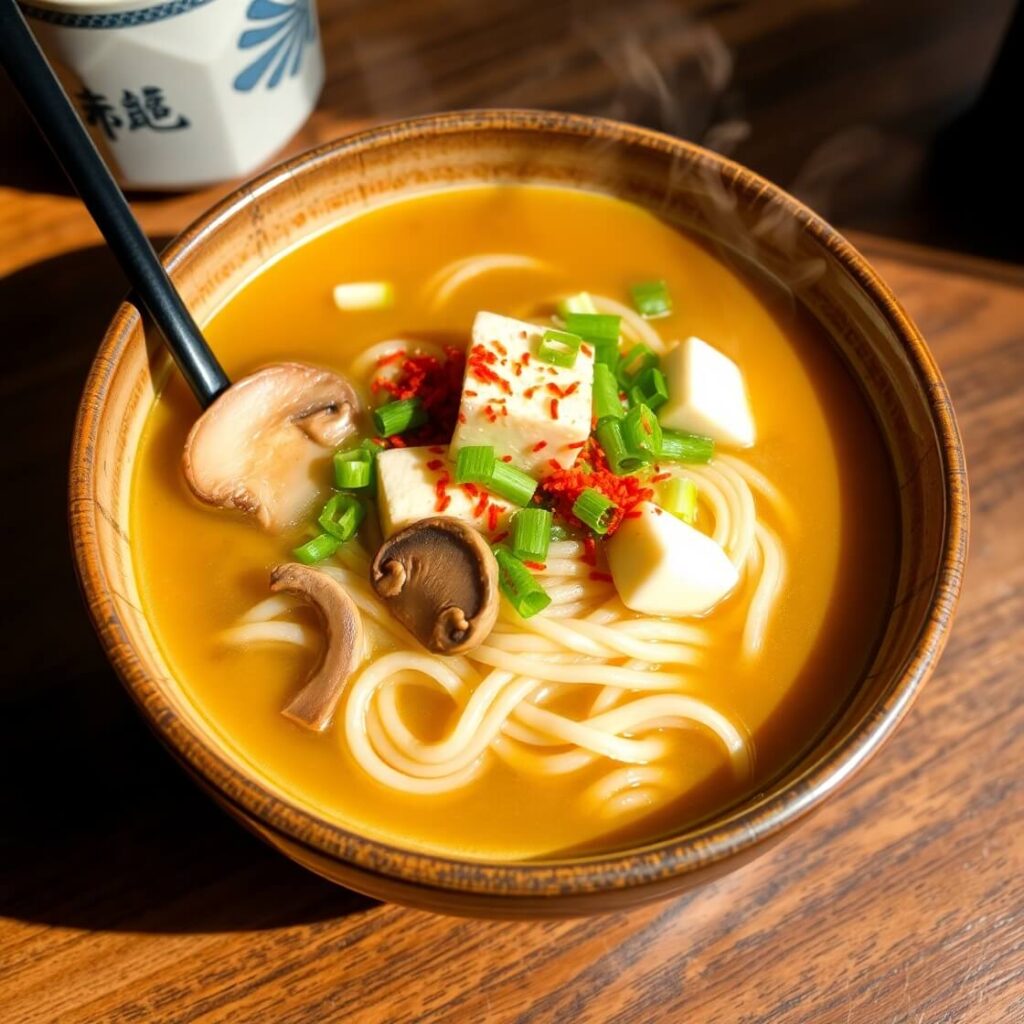
To really boost your udon noodle soup, start by making your own dashi stock if you have the time—it’s worth it. Using kombu (kelp) and dried bonito flakes creates a more complex, layered broth that store-bought powders can’t quite match.
Don’t overcook your noodles. Udon noodles are meant to be chewy, so cook just until tender but still springy. Overcooking can make them mushy and less enjoyable.
When simmering proteins or vegetables, add them towards the end to preserve their texture and freshness.
Try finishing the soup with a splash of toasted sesame oil for a subtle nutty aroma that rounds out the flavors.
If you enjoy a bit of heat, a pinch of shichimi togarashi or a few drops of chili oil can add warmth without overpowering the delicate broth.
Lastly, taste your broth before serving and adjust the soy sauce or mirin as needed to get the perfect balance of salty and sweet for your palate.
Common Mistakes to Avoid
One common mistake is boiling the noodles directly in the soup broth. This can cause the broth to become cloudy and overly starchy. Instead, cook noodles separately in boiling water and rinse them briefly with cold water before adding to the bowl.
Another mistake is rushing the broth preparation. If using dashi powder, make sure it dissolves fully and the broth simmers gently to develop flavor without boiling vigorously.
Avoid adding too much soy sauce at once; it’s better to start with less and adjust gradually to avoid an overly salty soup.
Be cautious not to overcook delicate toppings like tofu or greens; they should be added just before serving to maintain texture.
Finally, skipping garnishes or serving in plain bowls misses an opportunity to create an inviting meal — small touches make a big difference!
How to Store It
If you have leftovers, store the broth separately from the noodles to avoid sogginess.
Keep the broth in an airtight container in the refrigerator for up to 3 days. Reheat gently on the stove until warm but not boiling to preserve flavor.
Cooked udon noodles can be stored covered in the fridge for 1-2 days; refresh them briefly in hot water before serving to restore their texture.
Avoid freezing the soup with noodles inside as it can ruin the texture.
If you plan to prepare ahead, you can make the broth in advance and keep it refrigerated for up to 4 days or freeze it for up to a month.
FAQ
Can I use dried udon noodles instead of fresh?
Yes, but dried udon usually requires longer cooking and may have a different texture. Fresh or frozen udon noodles are preferred for authentic chewiness.
Is it possible to make this recipe vegan?
Absolutely. Use vegetable broth or kombu-based dashi and skip any animal proteins. Tofu and mushrooms make great vegan toppings.
What if I can’t find dashi powder?
You can make a simple broth by soaking kombu (dried kelp) in water and adding dried shiitake mushroom soaking liquid for umami. Soy sauce and mirin will help round the flavor.
Can I add other vegetables?
Yes! Spinach, bok choy, carrots, and green beans all work well. Add them towards the end of cooking to keep them crisp and fresh.
How spicy is this soup?
Traditionally, udon noodle soup isn’t spicy, but you can add shichimi togarashi or chili oil to your taste if you like some heat.

Udon Noodle Soup
A warm and comforting Japanese classic featuring thick, chewy udon noodles swimming in a savory dashi-based broth seasoned with soy sauce and mirin. This soup is simple, quick to prepare, and endlessly versatile with mushrooms, tofu, or thinly sliced meats. Perfect for cozy dinners or light lunches, it delivers rich umami flavor with a delicate balance of salty and sweet notes.
- Total Time: 25 minutes
- Yield: 2
Ingredients
- 6 oz fresh or frozen udon noodles
- 3 cups dashi stock (homemade or instant powder)
- 2 tbsp soy sauce
- 1 tbsp mirin
- 1 cup sliced shiitake mushrooms (optional)
- 4 oz soft tofu, cubed (optional)
- 2 scallions, thinly sliced
- 1 tsp toasted sesame oil
- Shichimi togarashi or chili oil (optional)
Instructions
- Combine dashi stock, soy sauce, and mirin in a pot. Bring to a gentle simmer.
- Cook udon noodles separately according to package instructions. Drain and set aside.
- Add mushrooms to the broth and simmer for 3-4 minutes.
- Gently add tofu or protein of choice and cook until heated through.
- Divide noodles between bowls and ladle broth with toppings over them.
- Garnish with scallions, drizzle with sesame oil, and sprinkle chili powder if desired. Serve hot.
Notes
- Use fresh or frozen udon for best texture.
- Adjust soy sauce and mirin to taste before serving.
- Avoid overcooking noodles to keep chewiness.
- Add vegetables or protein as you like for variety.
- Prep Time: 10 minutes
- Cook Time: 15 minutes
- Category: Soup
- Method: Simmering
- Cuisine: Japanese
- Diet: Vegetarian
Nutrition
- Serving Size: 2
- Calories: 280
- Sugar: 2g
- Sodium: 900mg
- Fat: 5g
- Saturated Fat: 1g
- Unsaturated Fat: 3g
- Trans Fat: 0g
- Carbohydrates: 45g
- Fiber: 3g
- Protein: 12g
- Cholesterol: 0mg

